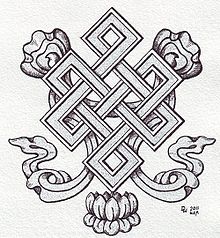This article needs additional citations for verification .(March 2019) |
| Endless knot | |||||||
|---|---|---|---|---|---|---|---|
 A common form of the endless knot | |||||||
| Chinese name | |||||||
| Traditional Chinese | 盤長結 | ||||||
| Simplified Chinese | 盘长结 | ||||||
| |||||||
| Tibetan name | |||||||
| Tibetan | དཔལ་བེའུ། | ||||||
| |||||||
| Mongolian name | |||||||
| Mongolian Cyrillic | түмэнөлзий | ||||||
| Japanese name | |||||||
| Kyūjitai | 終わりのない結び目 | ||||||
| |||||||
| Sanskrit name | |||||||
| Sanskrit | śrīvatsa | ||||||



The endless knot or eternal knot is a symbolic knot and one of the Eight Auspicious Symbols. It is an important symbol in Hinduism,Jainism and Buddhism. It is an important cultural marker in places significantly influenced by Tibetan Buddhism such as Tibet,Mongolia,Tuva,Kalmykia,and Buryatia. It is also found in Celtic,Kazakh and Chinese symbolism.